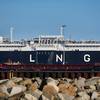"We've pretty much kept everything the same," says Mark Connally of Island Packers in reference to the sister ship to their two-year-old catamaran Islander. The new boat, as yet un-named, will have a few interior modifications such as more tables for the passengers and it will be a little beefier in the framing in recognition of the rugged waters and full loads that the Islander has experienced. Mark Connally and his partner Alex Brodie's company, which has a transportation concession for the California's Channel Islands National Park, currently operates two single-hull boats with 49 and 80-passenger capacities and the 149-passenger 65 x 24-ft. Cummins-powered catamaran Islander, delivered in mid March 2001. The new vessel, to be delivered this summer, will replace one of the single hulled boats while one will be retained for smaller charters.
Like the Islander, the new boat is being built by All American Marine, of Bellingham Wash.. This builder has a partnership with Auckland, New Zealand's naval architect Nic de Waal for the exclusive building rights to his unique Teknicraft catamaran designs on the U.S. west coast. Each of the twin Teknicraft hulls or sponsons employs a combination of symmetrical and asymmetrical shapes. The symmetrical bow-sections ensure directional stability in short swell conditions and following seas, while the asymmetrical amidships and aft sections ensures softness of ride and reduced wetted area that enhances comfort and economy. Horizontal steps on the inside of the tunnel walls act both as chines to deflect green water from the hull surface, and to break up the solid water into spray.
The vertical inside shape of the sponsons, reduces the planing area, thereby reducing the vertical acceleration forces. An additional feature in enhancing passenger and crew comfort is the action of the longitudinal chines on the inside of the tunnel walls. As solid green water is broken up into spray while being deflected from the hull, it mixes with air steaming down the opening between the sponsons. This mixture of spray and air creates a high-density medium inside the tunnel, which causes a dampening effect each time the hull moves through a trough of a wave.
The action of the longitudinal chines inside the tunnel, as well as wide chines on the outside, both deflecting water away from the hull, reduces the wetted area and therefore the resistance of the hull. The vertical inside shape of the sponsons minimized wave interference between the sponsons, which further reduces drag.
A hydrofoil system is fitted to the hull. The lift produced by the foil-system reduces the hull resistance, which increases speed; while at the same time increases the load-bearing capability. The foil action reduces the power needed to maintain service speed. Unlike conventional hydrofoils, which lift the hull completely out of the water, these foils are designed to only partly reduce the draft, thereby reducing resistance, but still maintaining good sea-keeping by having the hull still partly submerged.
The boat will be powered by a pair of emission compliant Cummins KTA19 M4 engines each delivering 700 hp @ 2,100 rpm into Twin Disc MGX 5114 quick shift marine gears with 2.5:1 ratios and turning 5-blade 36 x 42-in. Osborne propellers on three-in. Aquamet shafts.
At the launch of the Islander in 2001 Alex Brodie explained that the choice of Cummins engines was a combination of factors including their proven record in the demanding crew boat environment and their ability to meet the power to weight ratio needs of catamaran. Now, after the success of the Islander the owners see no need for change in the main engines. The new boat, to be delivered about June 2003 is expected to have a top speed of about 27 knots and a comfortable cruising speed of 24 knots at about 2000 rpm.
Featured videos

Inmarsat Enhances Service to Drive Digitalization

Unlock Onboard Data Efficiencies

Tracking Foreign Vessels Working in the U.S. Jones Act Market
Subscribe for
Maritime Reporter E-News
Maritime Reporter E-News is the maritime industry's largest circulation and most authoritative ENews Service, delivered to your Email five times per week









